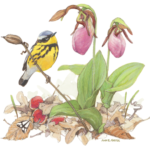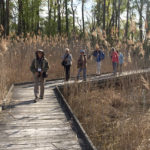The nine-member Ohio Bird Records Committee (OBRC) exists to increase knowledge of Ohio’s bird life by validating records, maintaining public archives of rare occurrences of birds in the state, and establishing the official list of Ohio bird species.
Recently, our own Jon Cefus, OOS Eastern Regional Director, was appointed Secretary of OBRC. To learn more about who they are, what it takes in keeping the records up-to-date and accurate and what you can do to help, please take the time to read Jon’s journey to the OBRC and it’s history:
Did you know that Ohio has an official list of birds that have been seen in the state? Who decides which birds do or do not count as having been seen here?
Like many of you who are reading this, I am relatively new to birding. The advent of social media and relatively inexpensive photographic technology, along with other factors, have resulted in a huge surge over the past decade of people watching and documenting birds. From backyard feeders to “Big Years”, this hobby, or avocation for some, has become something much larger than the relatively obscure passion of a few people held together by an interest in birds and relatively small communication circles.
A significant part of the enjoyment of birding for many people is listing. Listing is the activity of keeping track of what birds have been seen within a certain defined area. The defined areas can vary greatly. From one’s own backyard feeder list to a global list that includes all birds seen on earth, the ways that people list are wide ranging. Most of the listing takes place in defined geographical areas that have human-created boundaries. Common examples include county lists, state lists, and areas defined by birding organizations like the American Birding Association (ABA), which defines an area in North America used by those who are conducting an ABA Area Big Year. The ABA relies on states and provinces to define which birds can and cannot be counted in their geographical areas. I do not have time to go further into this in this article, but suffice it to say that there are many variables that go into this decision process.
The job of determining which birds go on to the official state of Ohio list of birds falls on to a group called the Ohio Birds Records Committee (OBRC). The first records committee was formed in 1981 by Ed Pierce and was called the Ohio Records Committee (ORC). This organization had no formal bylaws and existed to evaluate exceptional bird records for publication in The Ohio Cardinal. While a few other versions of that committee emerged throughout the 1980’s, in the interest of keeping this article from becoming too lengthy, I will skip ahead a bit. Around 1990, the ORC was dissolved, and in 1991 a new committee was formed in an effort to formalize the process of reviewing Ohio’s bird records by Ed Pierce and Robert Harlan. This organization developed bylaws that were modeled on the long-standing California Bird Records Committee and included defined lengths of terms for committee members and transparency in its decisions. The first OBRC members included Matt Anderson, Victor Fazio III, Jim Fry, Bruce Glick, Jean Hoffman, Tom Kemp, Tom LePage, Charlotte Mathena, Larry Rosche, David Styer, and Tom Bartlett as secretary.
In 2004, the OBRC partnered with the newly founded Ohio Ornithological Society and became a standing committee of the state organization, all while maintaining its own Bylaws.
The process of reviewing birds by the OBRC is well described on the Ohio Ornithological Society (OOS) website:
“OBRC reviews documentations of bird sightings, not the sightings themselves. Thus, the Committee’s task is not to decide if a given species was seen, but something much more specific: that the documentation provided by observers verifies, for the historical record, the species’ occurrence at the time. As in all scientific determinations, the observer of a phenomenon must offer acceptable documentation of the observation to peer reviewers. Significant records include not only those of species rare in the state, but also rare nesting records of birds that usually are only migrants, or occurrences of birds well out of season.”
Observers are asked to submit written documentation when they see a bird that would be a new species in the state, or when that bird species is one that is listed on the OBRC’s list of review species. The list of review species includes birds that are rarely seen in the state, and therefore require documentation of their presence. An example of this is Rock Wren, a bird that has been documented only 4 times in Ohio (3 accepted by the OBRC as of the writing of this article, and one to be reviewed). Under the Birding Resources tab of the OOS’s webpage, you will find in the dropdown menu a link for “rare birds”, which will take you to several resources as well as the current list of review species for the state of Ohio. That list will soon be reviewed and modified to reflect changes in Ohio’s birding dynamics since its last revision.
The OBRC serves a very important function in our state. While it is true that cameras and other technological tools have made documenting rare birds much easier, there are still sightings of some birds that the person(s) were not able to get diagnostic photos, video, or audio of to add to the validity of their sighting. In these cases, a finder of a rare bird is encouraged to write up an account of their sighting as thoroughly as possible so that the OBRC can review the report and cast votes to determine if the record will be accepted. Remember, it is not who saw the bird or whether the OBRC believes that the bird was seen, it is how well the observer documented that sighting that is being reviewed. The form for this can be found under the rare birds tab of the OOS website.
Perhaps, like me, you are an avid user of eBird to keep track of your sightings and add audio, photographic, and video media to those reports. Does that mean that you do not need to send a form to the OBRC? This is a tricky question to be sure. It is certainly true that eBird has changed the landscape of birding, and the process of reviewing new or rare state birds has been impacted by it. It is true that when there was no eBird, not every birder, or non-birder, was inclined to submit a report to the OBRC. Not everyone cares one way or the other whether a bird is accepted into the Ohio state records. If, however, you do care about Ohio’s official list, then it is important to try hard to properly document a sighting that represents a state review bird or a totally new state record. If you care about our state record and you are the finder of a new state record, then I am strongly encouraging you to submit that record to the OBRC for review, even if you use eBird and have done a good job of documenting the bird.
For some time, there has been some tension between the submitting of a physical document to the OBRC and submitting a checklist via eBird in terms of whether an eBird report is sufficient to be considered good evidence of a sighting. This is certainly a fair concern. Not every user of eBird is concerned with the quality of their reports. Reviewers volunteer their time to evaluate these reports and make decisions as to whether to validate a report so that it can be included in the scientific database of eBird. Reviewers cannot remove a bird from someone’s list, no matter how unlikely or rare the bird might be. The power of the review process only separates what is reasonably good science from poor data. Do these differences create an unbridgeable gap between the goals of eBird and the OBRC? I do not believe so.
The process of reviewing birds is evolving and there is certainly a both/and relationship that is possible for the OBRC and Ohio’s eBird users. As you read this, a process is being developed that will allow Ohio’s state and regional reviewers to submit reports of new Ohio birds and state review birds to the OBRC for review, even if the observer does not want to send in a written report. This effort will streamline the process and, if things work as we hope, will make the job of the OBRC secretary less overwhelming, as it has been in the past. It is hoped that this will allow more time for committee members to conduct the research they need to cast a vote on a nominate species, as well as take on the task of making informed decisions about whether or not to include a species like Trumpeter Swan on to our official state list after many years of introduction efforts in Ohio and surrounding states.
Some might think that the OBRC is no longer needed in our tech-heavy world. I disagree. This is not a zero-sum discussion. What the OBRC needs to do, as so many of our institutions do, is to evolve and grow with the world around us. In correspondence with Rob Harlan about this article and upcoming plans for the OBRC, he wrote: “Despite its ups and downs, the OBRC has now functioned for over 30 years, has rotated in approximately 60 voting members, and has resolved well over 1000 records, providing an approving endorsement for the great majority of these. I have always felt that current and future birders are best served by a peer review panel of experienced birders from around the state, with each member relying on their own unique backgrounds and viewpoints, and all in a transparent atmosphere. In a birding world now accustomed to virtually instantaneous eBird confirmations, I worry that others might think that the more deliberate OBRC is superfluous or irrelevant. Differing methodologies certainly exist, but both organizations serve vital functions, and actually, quoting eBird: ‘Does eBird follow records committee decisions? Because the eBird review process is much faster than review by records committees, we encourage eBird reviewers to make preliminary judgments for rare species in real time. We recommend, but do not require, our reviewers to follow the decision of the record[s] committee when it is ultimately reached.’”
Over the years, folks like Robert Harlan and the other dedicated members of the OBRC and its predecessors, have done the heavy lifting of trying to make Ohio’s official list of birds as high quality as possible, and we all owe them our gratitude. In the spirit of recognizing that heavy lifting, as Rob has provided me with much help with this article, I will give him the last words on this subject.
“I like the idea of the OBRC working in conjunction with eBird, and of course, many OBRC members are simultaneously eBird reviewers. Room for both? I think birding will be better for it.”



